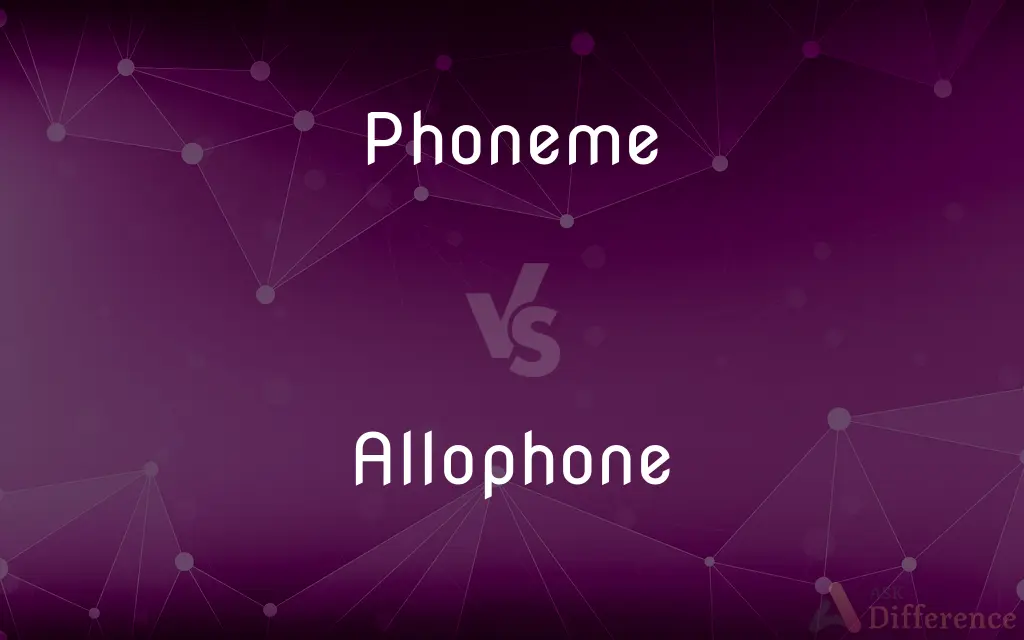Phoneme vs. Allophone — What's the Difference?
Edited by Tayyaba Rehman — By Fiza Rafique — Updated on September 30, 2023
A phoneme is a distinct unit of sound in a language affecting meaning. An allophone is a variation of that sound, which doesn't change the word's meaning. While phonemes are abstract, allophones are the tangible realizations of those phonemes.

Difference Between Phoneme and Allophone
Table of Contents
ADVERTISEMENT
Key Differences
Phonemes and allophones are fundamental concepts in the realm of phonology, the study of sound systems in languages. A phoneme is an abstract sound unit that can differentiate meaning in a language. For instance, changing a single phoneme can turn "bat" to "pat." Allophones, conversely, are variations of a phoneme that do not distinguish meaning.
The relationship between phonemes and allophones can be likened to the distinction between letters and their various fonts in written language. While different fonts might represent a letter, the letter (or phoneme) remains the same. In the same vein, while allophones might sound different, the underlying phoneme they represent is consistent.
The presence of allophones becomes evident when one phoneme has different pronunciations in different contexts, but doesn't alter the word's meaning. For example, the "p" in "pat" and "spot" are both allophones of the phoneme /p/, but their sounds are slightly different because of their positions in the words.
Understanding phonemes and allophones is crucial in language learning and teaching. While phonemes are essential to grasp because they influence meaning, understanding allophones can aid in achieving native-like pronunciation. Both concepts underscore the intricacy and dynamism of human speech.
In summary, while phonemes are theoretical sound units that carry meaning, allophones are the practical, audible manifestations of these phonemes in different contexts. One should note that while every language has phonemes, the allophones representing these phonemes can vary widely among languages.
ADVERTISEMENT
Comparison Chart
Basic Definition
Abstract sound unit affecting meaning
Tangible variation of a phoneme
Changes Meaning?
Yes
No
Example in English
/p/ in "pat"
Aspirated [pʰ] in "pat" vs. non-aspirated [p] in "spot"
Relation to Other
Theoretical entity, not bound to specific pronunciation
Specific realization of a phoneme
Role in Phonology
Helps differentiate words
Shows how phonemes are pronounced in different contexts
Compare with Definitions
Phoneme
Distinctive sounds that make up the sound system of a language.
English has around 44 phonemes, including consonants and vowels.
Allophone
Different sounds representing the same phoneme in various contexts.
English speakers use different allophones of /t/ in tap and butter.
Phoneme
An abstract representation of sounds that affect word differentiation.
Phonemes are central to understanding word pronunciation and meaning.
Allophone
Realized versions of abstract sound units in speech.
Every time we speak, we're unconsciously selecting allophones to represent phonemes.
Phoneme
The smallest sound unit that can distinguish meaning in a language.
Changing one phoneme can alter a word, like turning bit to bat.
Allophone
A variation in the pronunciation of a phoneme.
The l in leaf and full are allophones of the phoneme /l/.
Phoneme
A theoretical sound unit recognized by its function in a language.
A single phoneme might have multiple pronunciations across words.
Allophone
Audible manifestations of phonemes in specific situations.
Allophones illustrate how phonemes adapt to their phonological environment.
Phoneme
Sound categories within languages that determine word boundaries.
Phonemes help us distinguish bat from pat in English.
Allophone
In phonology, an allophone (; from the Greek ἄλλος, állos, "other" and φωνή, phōnē, "voice, sound") is one of a set of multiple possible spoken sounds, or phones, or signs used to pronounce a single phoneme in a particular language. For example, in English, [t] (as in stop [stɒp]) and the aspirated form [tʰ] (as in top [ˈtʰɒp]) are allophones for the phoneme /t/, while these two are considered to be different phonemes in some languages such as Thai and Hindi.
Phoneme
In phonology and linguistics, a phoneme is a unit of sound that can distinguish one word from another in a particular language. For example, in most dialects of English, with the notable exception of the West Midlands and the north-west of England, the sound patterns (sin) and (sing) are two separate words that are distinguished by the substitution of one phoneme, /n/, for another phoneme, /ŋ/.
Allophone
(Linguistics) A predictable phonetic variant of a phoneme. For example, the aspirated t of top, the unaspirated t of stop, and the tt (pronounced as a flap) of batter are allophones of the English phoneme /t/.
Phoneme
Any of the perceptually distinct units of sound in a specified language that distinguish one word from another, for example p, b, d, and t in the English words pad, pat, bad, and bat.
Allophone
Or Allophone(Canadian) A person whose native language is other than French or English.
Phoneme
The smallest phonetic unit in a language that is capable of conveying a distinction in meaning, as the m of mat and the b of bat in English.
Allophone
(phonology) Any of two or more alternative pronunciations for a phoneme.
[ʋ] is occasionally considered to be an allophone of /v/
Phoneme
An indivisible unit of sound in a given language. A phoneme is an abstraction of the physical speech sounds (phones) and may encompass several different phones.
Allophone
(Canada) A person whose mother tongue is neither English, French, nor (sometimes) an indigenous language of Canada.
Phoneme
(linguistics) one of a small set of speech sounds that are distinguished by the speakers of a particular language
Allophone
A person whose mother tongue is one other than that spoken by the majority.
Allophone
(Canada) Of or relating to those whose mother tongue is neither English, French, nor (sometimes) an indigenous language of Canada.
Allophone
That which is of a language other than that spoken by the majority.
Allophone
Any one of two or more speech sounds that considered variants of the same phoneme. For example, the p sounds of pin and spin are allophones of p; and the t sounds of toe stop and catnip are allophones of t.
Allophone
(linguistics) any of various acoustically different forms of the same phoneme
Allophone
Context-dependent sounds within the category of a phoneme.
The aspiration difference in the p of pat and spot showcases allophones.
Common Curiosities
Can changing a phoneme alter a word's meaning?
Yes, changing a phoneme can change the meaning, as in "bat" vs. "pat."
How many phonemes does English have?
English has approximately 44 phonemes, though this can vary with accents.
Is a phoneme an actual sound?
No, it's an abstract concept. The actual sounds are the allophones.
Are allophones unique to specific languages?
Yes, different languages have different sets of allophones for their phonemes.
Can an allophone of one language be a phoneme in another?
Yes, what's an allophone in one language might differentiate meaning in another.
Does changing an allophone change a word's meaning?
No, allophones are just variations of a phoneme and don't affect word meaning.
What's the primary difference between a phoneme and an allophone?
A phoneme is an abstract sound unit affecting meaning, while an allophone is a tangible variation of that phoneme.
Can one phoneme have multiple allophones?
Yes, one phoneme can be represented by different allophones depending on its context.
Why are phonemes important in language learning?
Understanding phonemes is essential for grasping word meanings and pronunciation.
Are phonemes always consistent in pronunciation?
No, their realized sounds, or allophones, can vary based on context.
How can two allophones belong to the same phoneme?
If their difference doesn't change word meaning, they're allophones of the same phoneme.
Can a sound be both a phoneme and an allophone?
In a sense, yes. It's a phoneme in abstract terms and an allophone in its tangible realization.
Do allophones play a role in language teaching?
Yes, teaching allophones can help students achieve native-like pronunciation.
Why might languages have different allophones for the same phoneme?
Phonological rules and historical changes can lead to different allophone realizations.
Is understanding allophones necessary for everyday communication?
Not necessarily, but it's beneficial for linguists, educators, and language learners.
Share Your Discovery

Previous Comparison
Magnesium vs. Manganese
Next Comparison
Impure vs. UnpureAuthor Spotlight
Written by
Fiza RafiqueFiza Rafique is a skilled content writer at AskDifference.com, where she meticulously refines and enhances written pieces. Drawing from her vast editorial expertise, Fiza ensures clarity, accuracy, and precision in every article. Passionate about language, she continually seeks to elevate the quality of content for readers worldwide.
Edited by
Tayyaba RehmanTayyaba Rehman is a distinguished writer, currently serving as a primary contributor to askdifference.com. As a researcher in semantics and etymology, Tayyaba's passion for the complexity of languages and their distinctions has found a perfect home on the platform. Tayyaba delves into the intricacies of language, distinguishing between commonly confused words and phrases, thereby providing clarity for readers worldwide.
















































